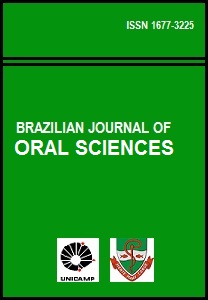Abstract
The goal of this investigation was to evalute the healing process of class III furcation defects treated with resorbable membranes. Five mongrel dogs were used. Class III furcation defects were surgically created and exposed to plaque accumulation for 3 months. After this period, the defects were randomly assigned to one of the treatments: ATR= non-sutured resorbable barriers (Atrisorb ®), GUI= resorbable barriers stabilized with sutures (Guidor®), OFD= open flap debridement and NTC= non-treated control. After 3 months, the dogs were sacrificed and the blocks were processed. The histometric parameters evaluated included linear and area measurements. The defects treated with membranes presented a superior length of new cementum when compared to NTC (P<0.05) but no statistically significant differences when compared to OFD. The new bone length of GUI was superior to OFD and NTC (P<0.05) but showed no significant difference with ATR. The new bone area was greater for GUI than for NTC (P<0.05) but no statistically significant differences were observed among ATR, GUI and OFD. It can be concluded that the resorbable barriers (GUI) can provide a better bone response but the treatment of class III furcations has to be considered still unpredictable.The Brazilian Journal of Oral Sciences uses the Creative Commons license (CC), thus preserving the integrity of the articles in an open access environment.
Downloads
Download data is not yet available.

